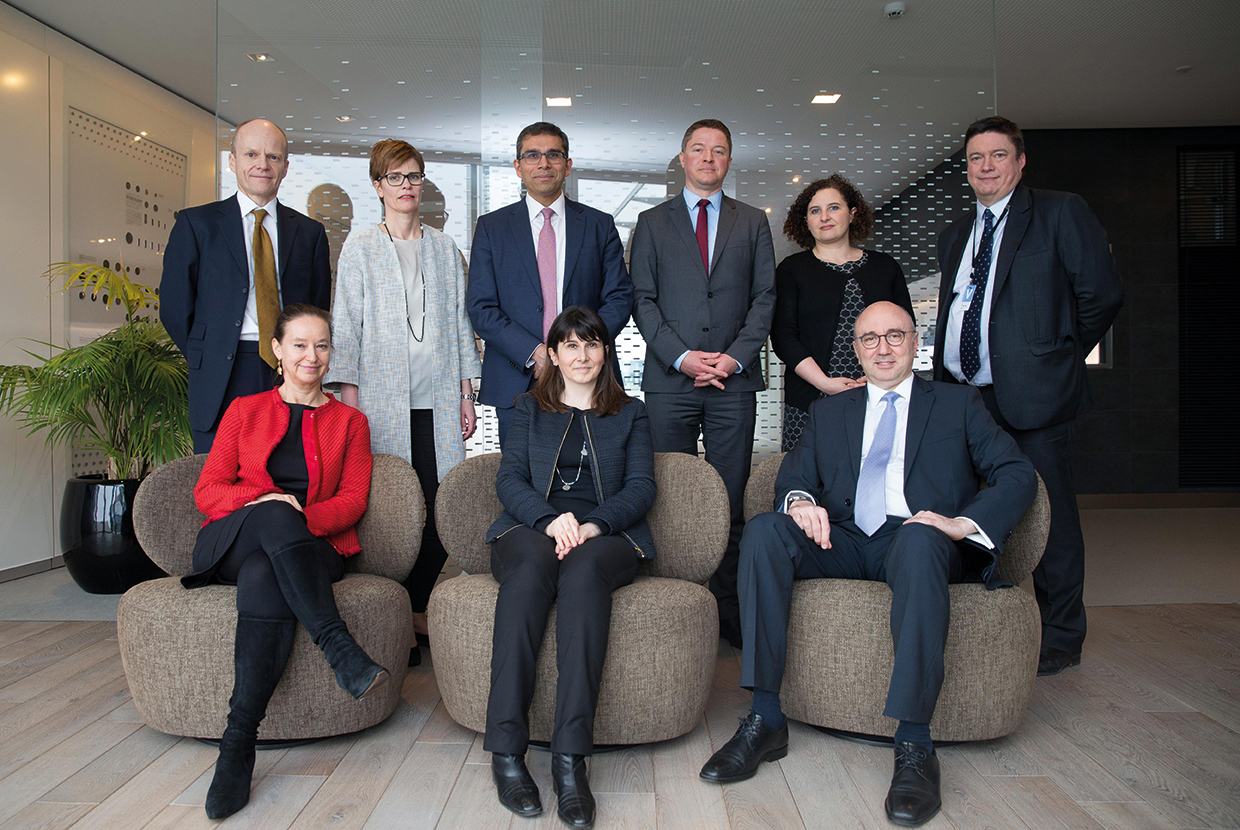Faced with an increasingly volatile political environment, participants at GTR’s annual export finance roundtable discussed the full gamut of micro and macro trends impacting the business, as well as increased competition and discrepancy between export credit agencies among other key issues.
Roundtable participants:
- Eriks Atvars, global head of structured trade and export finance, UniCredit
- Kathrin Eich, global head of export and agency finance, Commerzbank
- André Gazal, global head of export finance, Crédit Agricole CIB (chair)
- Virginie Gode, director, export and specialised finance, HSBC France
- Tim Lamey, senior director, head of export finance, Emea, Mizuho
- Faruq Muhammad, head of structured export finance, Emea, Asean and South Asia, Standard Chartered
- Hacina Py, head of export finance, Société Générale
- Simon Sayer, head of structured trade and export finance Emea and global co-ordinator, Deutsche Bank
- Clarine Stenfert, managing director, export finance, global infrastructure head, JP Morgan
Many thanks to Crédit Agricole CIB for hosting the discussion at its Paris headquarters.
Gazal: From a macro perspective, 2017 appeared to be a year in two parts: a very slow start on the heels of the slowdown in 2016 due to the impact of commodity prices on investments, and then a second half of the year where we saw some significant transactions being signed and a general pickup of pace. What do you see as the factors behind this turnaround, and do you see this carrying through to 2018?
Sayer: I’ve tried for years to pick out micro trends, but I have come to the conclusion that it is impossible. There are some broad trends – the market is travelling up or down – and because the projects are so large, it is a lumpy business. It just depends which side of the month end or the quarter end or the semester that a particular project falls into. If there are one or two large deals in a particular year that don’t get replicated in the following year, then suddenly there is a trend in a sector as well.
In terms of sectors, telecom is super important, and that is in developed markets as well, which is quite unusual. Power and oil and gas are down generally, and that reflects our business too. Transport is up, but that does include things like cruise ships as well as metro projects and rail projects. If you think about those sectors and what that means for the geographies, then developed markets – the US – was a huge and important market for the ECA business last year.
The Middle East is growing, but that reflects the fact that oil and gas is down. Our experience is that Africa continues to grow, and there were a couple of large projects last year which helped keep those figures up. But it is projects that are in the tens of millions and hundreds of millions, not necessarily billions, which are responsible for a really strong underlying trend in Africa. The business is really encouraging.
Stenfert: The trend for bigger project finance transactions is continuing, especially in the Middle East. At the end of this year, or maybe in 2019, there could be one or two large projects in Asia as well. For us, oil and gas is still quite significant, where it should be perhaps a bit more depressed. In particular, we are still seeing a number of refinery projects. In terms of other sectors, renewables, which everybody had high hopes for, is progressing pretty slowly.
Atvars: The momentum that we felt in 2017 has now materialised in quite a few bigger ticket transactions – in particular in cruise ships, where there is a lot in the pipeline right now, and the defence industry.
Gode: The cruise ship industry has been very active over the last few years, and we saw a peak last year. In our view, this trend will keep going for 2018. We also saw an increase in the telecom business, excluding space, last year. The question is whether this will continue to build in the coming months and years.
Gazal: Are we seeing more ECA business being done in OECD markets? And if so, are the ECAs well adapted to that?
Gode: The market is evolving, we all recognise that. We are seeing more and more demand from OECD, developed countries. I think that for the ECA business, it is very good, because it is a diversification of our portfolio, and also of our risk. The point is that we are here to assist the supplier in making sure that we can give them the opportunity to compete and to offer the most efficient solution.
Lamey: It is a trend that took off at the time of the financial crisis. There is a selective range of countries that see a lot of interest in the sector, the US being the largest one, but also Japan, the UK and other parts of Western Europe. As to how well prepared ECAs are for the process, I think it varies. There are one or two that have done more business in those parts of the world that have come to terms with the pricing model required and so on, while elsewhere there is a very low level of knowledge and preparedness. But we certainly see it as something that is going to continue from our side.
Sayer: Finance for developed markets should be something that is allowed in the same way that finance for developing markets is allowed – for the very simple reason that we should be encouraging fair trade and fair practice. If telecoms providers, airlines, cruise ship operators, steel manufacturers or car manufacturers in developing countries have access to long-dated finance for their capital expenditure, then so should borrowers in developed markets, because it is an international marketplace. It would be wrong to deprive them of the same financing tools that are available elsewhere.
I think it will continue, and for the relevance of the product, I think it has been marvellous. Our backgrounds are in emerging markets, but if you finance clients in developed markets, usually the rest of the bank has a very strong interest in what is going on. It is very welcome attention, and we make ourselves much more relevant to the rest of the bank’s client base.
Eich: We have looked into smaller deals for developed countries, but with the introduction of the new category 0 premium calculation, the premium was comparably high and the financing did not materialise. There has been a very strong discussion with the ECAs involved as to if that is the right approach to ensure that we have a level playing field.
Atvars: It goes hand-in-hand with where regulation has forced banks to focus their efforts, and likewise, in certain regions, the diversification of sources of funding has helped. For example, Middle East volatility in long-dated US dollars has been happily replaced by some ECA financing. Right now there is a lot of interest from the lending industry to focus on those efforts. We all have a very strong core client market focus. It is a popular theme these days, so why not also finance investments in our home markets?
Sayer: In terms of how well ECAs are equipped for it, there are some real issues that ECAs are still wrestling with on the category 0 premium calculation. There is also the provision of commercial interest rate of reference (CIRR) for developed markets. And underwriting credit in developed markets, too, because it is no longer just a sovereign or a state-owned entity, it is typically a corporate.
Gazal: There are a couple of ECAs that have done a good job at supporting exports to OECD markets, but others are perhaps still focused on their emerging market models and do not have the ability to provide the same kind of service and follow-through on these transactions, particularly when these go into default. We have seen this happening in Western Europe. Is that something that you feel the ECAs can improve upon?
Lamey: It is the area where we see the biggest variance between ECAs and their ability, readiness and qualifications to handle developed country business. One or two approach that model on a very constructive, creative basis. Some of the others are barely aware of the model. I think there is a huge amount of work to be done by some ECAs if they believe that that is business they should be doing. Another question would be whether they really believe that that is business that they should be doing. One or two ECAs are notable by their absence. Whether it is an implicit or a real reluctance, I don’t know.
Stenfert: The mandate of the ECAs is to support their exporters. They are not development finance institutions, so if they need to support an exporter in an OECD category 0 country, they should be able to do so.
Atvars: You definitely have some champions who are pushing the envelope in developing their national economic interest, and others who are being more conservative and sticking to the grain of national content. That drives a lot of these flexible solutions. It will be interesting to see how they develop.
Gazal: We are all witnessing much more competition between ECAs. They have developed new processes and products, including direct loans, and they are trying to get the edge over their neighbours. How do you see this evolving, and where do you think this leaves the banks in this equation?
Sayer: I think that direct lending is here to stay. I’m convinced of that. The areas in which the ECAs have been competing aren’t just restricted to direct lending. There are lots of different areas, such as national content rules, the ability to support CIRR, category 0 premium benchmarks, and things like being prepared to support swap breakage costs embedded in loans.
It leaves us banks in a fantastic position to give our clients the benefit of our know-how around what has never been a more dynamic marketplace. There have been more new products introduced over the last few years than at any previous time, and being able to remind clients what might be available with a little bit of push, and that under competitive situations, ECAs are prepared to take further steps than they have ever before in certain areas, puts us in a great position with the experience that we have.
Frankly, my position on direct lending is that I welcome it to the extent that it is provided in a way that continues to involve the banking community, and there are some very good examples of that, like the Nordic ECAs in particular. I don’t think any of us are particularly comfortable with the very sort of dominant direct lending programmes, like that of US Exim when it was up and running, which didn’t really provide much of a role for the banks except as an agent.
Muhammad: In some cases, particularly when you are working with sovereigns in Sub-Saharan Africa or the Middle East, the direct programme works really well because it gives the whole transaction more of a government-to-government flavour than it would if you came in as a bank lending under ECA cover. We saw this work well in one particular transaction which we got over the line last year.
In the private sector where there are more sophisticated borrowers that have a system of managing banks, our approach will always be to welcome a bank-funded rather than direct-funded solution. Except for a few ECAs who run direct lending in a very different manner, most of the ECAs have a role for the bank to play, and they do depend on the bank to do a lot of the front-end work on the transaction. It is a matter of horses for courses rather than a good or a bad thing.
Stenfert: In a way, the role of the bank almost becomes bigger, because you need to advise your client on all the different tools that are available. There are so many different programmes, so for the client it is quite difficult to understand who is offering what. The bank involvement helps the ECA, the exporter, and the borrower as well, because the bank maintains an ongoing dialogue with its clients and therefore usually knows the borrower better than the ECA.
Gazal: We have mentioned CIRR – are there any thoughts on CIRR being reviewed and adapted to the reality of the marketplace?
Sayer: That is a really interesting question, but it is also one that has been asked for the last 15 or 20 years, and a couple of ECAs opted out of the CIRR market completely, notably UKEF. Nobody else followed them, so they felt obliged to reintroduce it. Therefore, I think the chances of the OECD agreeing on this are still slim, because there will always be some OECD members who want to see a CIRR rate continue. Is it possible? Yes, and probably more than ever with government budget deficits in almost every OECD member country. There ought to be conversations around that.
Eich: They might put in new parameters, or new eligibility criteria, just to limit capacity.
Gazal: I would think an adjustment to the rate, as opposed to the offer of the CIRR as a fixed rate, and where a compromise could perhaps be reached between different countries struggling with budgetary issues and the subsidy element of CIRR, particularly in a rising rate environment.
Sayer: Another observation on this as a topic is that we only tend to talk about it when rates are expected to rise, and rates have been very stable and very low for a long, long time. Indeed, now they are rising de facto, but in that environment, there is tremendous value in the CIRR, so the question naturally gets asked at the moment when there is a lot of value in the CIRR. It doesn’t tend to come up so much when rates are falling and the CIRR looks expensive.
Gazal: Let’s turn our attention to trade wars. The prospect of a trade war has never been as high as in recent months, so I would like to know if the US administration imposing tariffs on goods from their most trusted partners is something that you see as a threat to export finance? Or are you not concerned?
Stenfert: I am less worried about ECA finance and more about the broader impact, to be honest. The prospect of a trade war makes everything very volatile, which is never good. In terms of ECA finance, if US Exim were open, it would probably feel the effect more acutely. With the other ECAs and trade volumes, I don’t see the impact yet.
Atvars: As volatility increases, the financial markets become more uncertain in terms of alternative capital markets solutions, so the safe haven of ECA finance might actually benefit from that. I am less concerned at face value about the threat of a trade war and much more focused on what could happen in individual domestic industries and economies.
Muhammad: ECA volumes compared to global trade volumes are minuscule. I would argue that you could see more of the OECD-type ECA deals in the US, where they may decide to build plants rather than import. There might be an opportunity there for those who actively play in that market. I think everyone is waiting to see how this actually plays out. Basically, President Trump is doing what he promised during his campaign, so it is nothing unusual.
What’s more significant are the opportunities brought about by the Belt and Road Initiative – it is important to track how things are developing there. I see a lot of countries wanting to be part of it. China is trying to become more international with that approach rather than their historic approach of following their own companies outside the country.
There is certainly an interesting world developing with this. It is probably not something that I would expect to impact on our business in this year, but it could have repercussions going forward.
Sayer: I disagree because I think already it has had quite a big impact on our world. My view is that the trade war has been simmering for the last three or four years, and it has been quite covert, under the surface. It’s been the sort of competition between ECAs that we have seen where national interests are promoted. The flexibility and the development in products that has come from the export credit market has been because of an underlying trade war. What has changed now is that it is becoming more overt. If you like, the gloves are off, and the language around trade is now becoming more aggressive and is discussed more openly.
I think the possible consequence is that there will be more product development among the export finance community, and even more change to our marketplace. It probably provides more opportunity than threat going forward. Anything that threatens the export finance model is a bit uncomfortable. But at the same time, we can’t deny that it has been responsible for a tremendous change in the business.
Gazal: There are underlying currents which dictate this kind of policy, and as long as it is limited to a trade war of words and of little action and escalation – which could lead to some geopolitical instability – then I think I agree that it could be an opportunity. Otherwise, it could be something much more impactful than that.
Stenfert: The bigger issue is the question of sanctions. With everything that is going on, it has become such a complicated field to navigate. It isn’t always clear what is and what isn’t covered, and you don’t always get the same answer even from two people within the same ECA. Where ECAs take an active role in the documentation, we find ourselves caught between internal policy and the ECA’s position. Additionally, the ECAs are not very aligned on sanctions and this complicates documentation negotiations for multi-sourced projects.
Gazal: Sanctions clauses, anti-corruption and similar reporting and tighter KYC are making our banking activity more complex to manoeuvre in. Already, export finance is a complicated product. When you add these requirements, which some borrowers object to, what are the risks of them switching to an alternative liquidity source that might be less constraining?
Lamey: I am not sure that KYC or sanctions issues, which have increased progressively over the last few years, have had much of a product-specific impact. I don’t think that people would switch out from ECA to an alternative product, because I don’t see many instances where there may be heightened KYC or sanctions processes or requirements specifically because it is ECA-based.
Sanctions are another area where there is no kind of uniformity between ECAs at all, as far as we can see. We had an example which several of us will be familiar with from late last year when a couple of ECAs took very different views on the sanctions aspects of a transaction. But I am not particularly clear that that would necessarily impact unfairly just on our product, really. I think that KYC and sanctions are a challenge across the board, irrespective of what product you are extending.
Gazal: The capital markets are perhaps more flexible, and have less demands on documentation than an ECA loan which some borrowers find more complex. The fact that the ECAs are not aligned also adds to the complication, as lack of ECA uniformity on treatment of, say, sanctions clauses makes ECA financing less predictable. Banks also have their own internal requirements. There are definite discrepancies there. Could that be a threat?
Gode: I don’t think that there is a different approach from the ECAs compared to other types of products. The capital market is certainly more straightforward in terms of delivering the process. But the industry is evolving, and we may not yet have reached what we need to on that aspect: the OECD and the ECAs need to have a more co-ordinated approach.
Muhammad: We would certainly welcome ECAs being more aligned in their approach to sanctions, because on the banking side we are already fairly aligned. We all know where our lines are, and we would walk away from a transaction. On the capital market solutions, they will certainly always be lighter. Borrowers will always choose a non-ECA solution if they have availability of commercial financing, whether through local or capital markets, because they don’t want to go through all the hassle of the ECA requirements.
Maybe this is something that gets mentioned at the Berne Union level – that there needs to be alignment and consistency among ECAs so that they are more aligned to how banks operate. But I can appreciate why they would have different parameters. For example, many ECAs want to support transactions in Iran – and a lot of banks can’t do that.
Sayer: The extent to which the banks have been asked to step up and regulate the international trade marketplace has completely left behind the ECAs and the OECD, and there is now a huge gap in terms of what is expected of us, and what their framework for operating is. I’m talking about KYC, also to some extent sanctions and the lack of commonality around that, both anti-bribery and corruption and anti-financial crime. All of those things are very outdated in the OECD.
The last OECD guidance around this was in 2006 – 12 years ago – on bribery and corruption issues. Now, I understand they are working on something new, which will be extending the public sector requirements to the private sector, which is overdue, but it has been quite convenient I think to rely on the banks and expect the banks to do this, and I am quite uncomfortable with the gap that has been created. It used to be the case that we would be able to say that we were very happy with our due diligence on a project, including KYC and anti-bribery and corruption and anti-financial crime, because an ECA is involved. And now that is no longer acceptable, at least in our institution, because what is expected of us has reached a much higher level of detail.
Gazal: There are definitely discrepancies from one country to another. Some ECAs don’t take sanction risk at all. The DFIs don’t either. So, they are putting a lot of the responsibility on banks to assume that risk, and with the potential loss of policy if we don’t respect the sanctions, which when you think about all the things that we have to deal with as banks, managing the loan, it adds a substantial amount of additional risk and due diligence, which I don’t think many people realise is assumed by banks.
Let’s talk about regulation. The good news is that in Basel III, there was an exemption of most export credits from the leverage ratio. Regulation related to corporate risk and FI risk was announced in December, and a discussion paper was circulated on sovereign risks, which – if it went further – would be of concern to our industry in general. I want to collect some views as to whether you consider the regulation to be a real threat and whether there could potentially be an uneven playing field if national or regional discretions were exercised?
Sayer: I think that is one of the reasons why it won’t get implemented in its current draft. First of all, it certainly is a threat. If, as currently drafted, it were implemented, then it would have an effect on our business. But we are such a small part of the market for sovereign lending, we are a very small voice in this process. And in all the responses that have gone into the discussion paper, everybody has made a point of having a mention of export credits as being something that should be treated as an exception. I take quite a lot of comfort from the fact that the potential exception to the leverage ratio seems to be moving forward, and that something similar might apply to sovereign risk in export finance also.
There is one thing in there which I think is really interesting for the business, which is around this whole topic of national discretions. Notwithstanding the agreement on what everybody signs up for, you have still got a kind of unilateral carveout to have a national discretion on your own sovereign and your own ECA. There is a hint that some of those national discretions would be tightened up. That actually might be a good thing, because it would have more of an equalising effect across the business. Yes, it is a threat, but I am not losing sleep over it, because I think all the precedents suggest an acknowledgement of the albeit relatively small part that the export finance market plays, and it would in all likelihood be exempted.
Muhammad: I took comfort in reading it. It started in the beginning of 2015, and it is now presented not as a consultation paper but as a sort of input and discussion paper. I think we have some distance to go, and I think it will be watered down to a large extent before it actually hits in whatever form. Hopefully not in the next few years.
Gazal: There is a lot of talk about innovation in trade finance, with digitisation and blockchain. Does anybody see a potential application of technology to export finance to facilitate our daily lives and lighten the load?
Muhammad: A lot of the deals that we do are fairly customised, and I think they will always be. Maybe there is some technology that can manage the eligibility content and track that. But, at least in our institution, this business is still a specialised area, where we don’t see the sort of volumes which will benefit from a lot of automation.
Atvars: In terms of the sheer number and volume of systems and processes that you have to go through in booking and administering payments, we can definitely see a benefit through innovation. That is not going to change how we do our business; it will perhaps just speed up the process – until that transaction is agreed, a commercial agreement is found and it is signed, this is still a people business at its core.
Gazal: We are reaching the conclusion of this roundtable, so it is prediction time! If you were to pick one positive or one negative event that is going to happen in 2018, what would it be?
Stenfert: I’m going to say that US Exim reopens.
Lamey: How about the alternative, which is that US Exim doesn’t reopen, US companies give up waiting and move pipeline business, in cases where supporting finance is critical, elsewhere.
Eich: Predictions for the business outlook for certain ECA markets are more and more difficult due to the volatile political environment and new sanctions potentially being imposed.
Sayer: I expect volatility, but in a positive sense. Already this year we have had much more volatility than in the previous 18 or 24 months, and I think that will be really positive for our business. Uncertainty around continuity of finance, interest rates and potential trade wars will mean that there is a much greater urgency to lock in financing.
Muhammad: Some of the commodity prices have stabilised, and if that continues, coupled with a lot of political stability in the emerging markets, it will continue to drive demand for this product in the emerging markets.
Atvars: Despite the prevailing mood in this room over the last hour about the discontinuity across ECAs, my bold prediction will be that as we near Brexit, and as we have more volatility and trade wars, overt or covert, the European ECAs are going to find more common ground to push an already growing economic trend to support domestic industries more effectively. We are seeing it now already – there are a few ECAs that are already pushing the boundaries.
SMBCE’s Joseph-Horne on export finance market
GTR caught up with Jonathan Joseph-Horne, managing director, co-head of structured export finance at SMBC Europe and chair of the ICC Banking Commission’s recently formed Export Finance Committee, for his views on the market.
GTR: ECA direct lending is a topic that traditionally has divided opinion in the market. What are your views on this product?
Joseph-Horne: I am very supportive of the concept of direct lending in its various forms and feel it has an important role to play in the market. It is not a ‘one size fits all’ product and there will be cases where it is unnecessary or inappropriate, but also plenty of others where it can be the best solution for the client or at least can be part of the right solution. It’s important to differentiate between ECA direct lending, ECA co-lending and ECA funding solutions as different ECAs provide different products and there can be a tendency to bundle them together as a single product. This is not the case and is one reason why I feel that these solutions have a lot to contribute no matter where we are in the cycle. Depending on how they are applied they have the capacity to address combinations of funding, transaction liquidity and risk mitigation needs.
GTR: The geopolitical environment continues to be quite uncertain. What are your views on the current market conditions?
Joseph-Horne: Export finance is traditionally a counter-cyclical product. While this is a huge over-simplification, it is certainly the case that it is well equipped to help exporters and borrowers ride out geopolitical headwinds. It’s an inherently stable and reliable source of finance, and after its performance during the global financial crisis it has nothing to prove in terms of its ability to deliver in volatile times. In short, I am optimistic about the demand for and the deliverability of structured export finance solutions in the current environment. Trade flow will continue even though some of the patterns will change and it is exactly this type of changing environment that plays to the strength of this product set. As bankers and ECAs, it is our job to get ready to deliver.
GTR: You recently took over as chair of the ICC Banking Commission’s Export Finance Committee. Can you explain a little about the committee’s role and purpose?
Joseph-Horne: The committee’s role is to create a credible global discussion forum for banks experienced in medium and long-term export finance, to create a representative body to discuss industry matters with stakeholders such as the Berne Union, and to advocate for and help develop improvements and efficiencies through standardisation and harmonisation of processes and regulations. In terms of what this means in practice, the committee currently comprises 14 banks active in export finance and I would like to expand this to 20 or more if there is interest from the market. We have dedicated working groups focused on interaction with stakeholders such as the Berne Union and on stimulating a broad and open discussion on topics like sustainability. We are also actively engaged in discussion and advocacy on topics such as the leverage ratio and treatment of sovereign exposures at the regulatory level. We are very lucky to have committee members who are genuine experts in these areas and also benefit from the support of the wider ICC organisation. The ICC itself is the world’s largest business organisation, has observer status at the UN General Assembly and engages actively at the WTO and G20 to ensure the voice of business, including export finance, is heard.


















